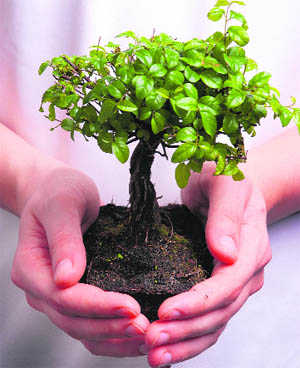Bonsai care in monsoon season
Maj Gen CS Bewli
Bonsai plants have a deep attraction for gardening lovers as creating a bonsai successfully remains the ultimate test of a gardening enthusiast’s skill as well as passion for plants. Rainy season is the season when plants thrive but if the required care is missing then the excess water can also ruin your garden. This is all the more relevant in the case of bonsai plants. The monsoon season can be used to boost the beauty and growth of your bonsai and win the test of your gardening skills with flying colours.
Bonsai plants reflect their best growth during the rainy season. This also happens to be the right time to rejuvenate them by repotting and placing the plants in a fresh and nutritious soil mix.
Here are some important tips that you should put in use during the rainy season to make your bonsai thrive.
Fertlising
Bonsais are grown in a very restricted area, thus the soil mix plays a very crucial role in the growth of the tree. The very basis of bonsai is to maintain a healthy root structure. In nature, plants send out many roots in various directions in search of water and nutrients, but these plants when trained as bonsai need to be fertilised since their roots cannot go out of the container to find nutrition.
Fertilisers form an integral part of soil fertility and texture. The fertility of the soil largely depends on the amount and rate at which the nutrients are provided to it periodically. For healthy growth of bonsai regular supply of essential nutrients is required.
The three major macronutrients for the balanced development of bonsai are : Nitrogen (N), phosphorous (P) and potassium (k).
For ease in handling, compounds containing these elements are often mixed to make a complete fertiliser. The amount of each element present in such fertiliser is known from N: P: K ratio mentioned on the package. Thus 9:23:16 shows that the fertiliser has 9 per cent nitrogen, 23 per cent phosphorous and 16 per cent potassium by weight. This combination is suitable for bonsai and is prepared by mixing 2 parts of di-ammonium phosphate (DAP) and 1 part of potassium; both are available in the market. Though NPK in the ratio of 19:19:19 is available in the market, but due to its large nitrogen content the leaves tend to get bigger where as the whole fight in creation of bonsai is reduction in size of leaves.
Correct soil mix
To keep bonsai healthy at all times they must be grown in the right soil mix. Characteristically, the growing medium should be:
- Nutritious
- Porous
- Be able to retain moisture without water logging
- Loose to the touch and freely draining
- Able to hold the plant
Styling
Monsoon is also the time to train and shape your bonsai as there is a growth spurt and the results of your labour can be seen sooner. Wiring is imperative when it comes to bonsai styling and training. Though wiring can be done at any time of the year, but monsoon is undoubtedly the right time. Wiring done during this period give speedy and steady results because of accelerated growth rate of bonsai. Pruning is also one of the most effective techniques in maintaining the style of bonsai and again this is the most appropriate time to carry out this activity
A short period of over-watering, say 1-2 weeks, does not damage a bonsai; therefore heavy rain during this spell will not kill it. Chronic overwatering, however, can be damaging. Bonsais should be given shelter in case of incessant rains, which do not allow soil to dry out for a long period of time.
— The writer is the President of Bonsai Culture Society, Chandigarh and President of National Cactus & Succulent Society of India









